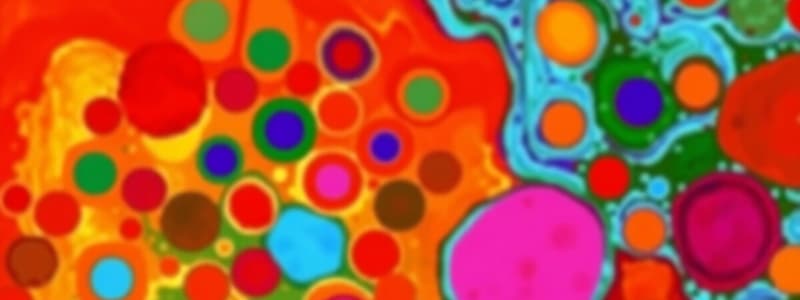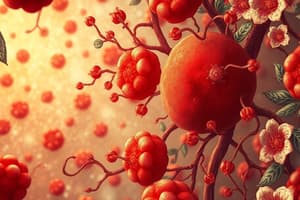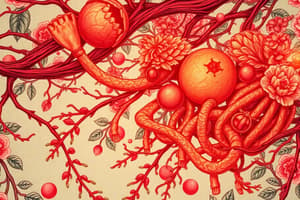Podcast
Questions and Answers
What is the primary role of erythropoietin (EPO) in hematopoiesis?
What is the primary role of erythropoietin (EPO) in hematopoiesis?
- Regulates lymphocyte maturation
- Stimulates platelet production
- Inhibits monocyte formation
- Controls erythroid proliferation and differentiation (correct)
From which stem cell type do erythrocytes (red blood cells) originate?
From which stem cell type do erythrocytes (red blood cells) originate?
- Lymphoid stem cells
- Myeloid stem cells (correct)
- Uncommitted progenitor cells
- Multipotent stem cells
What factor primarily stimulates the secretion of erythropoietin?
What factor primarily stimulates the secretion of erythropoietin?
- Elevated thyroid hormone levels
- Increased iron levels in the blood
- Tissue hypoxia (correct)
- High oxygen saturation
Which of the following cell types is NOT classified as a supportive cell in hematopoiesis?
Which of the following cell types is NOT classified as a supportive cell in hematopoiesis?
What is the significance of self-renewal in the context of hematopoietic stem cells?
What is the significance of self-renewal in the context of hematopoietic stem cells?
Which type of stem cell directly gives rise to megakaryocytes, the precursors of platelets?
Which type of stem cell directly gives rise to megakaryocytes, the precursors of platelets?
Which growth factor specifically stimulates the production of granulocytes?
Which growth factor specifically stimulates the production of granulocytes?
Which nutrient is essential for the production of red blood cells and is often a part of supplementation in diets?
Which nutrient is essential for the production of red blood cells and is often a part of supplementation in diets?
What is the primary function of hematopoiesis?
What is the primary function of hematopoiesis?
Which cells are found in the red bone marrow involved in the erythropoiesis series?
Which cells are found in the red bone marrow involved in the erythropoiesis series?
In which location does extramedullary hematopoiesis occur during severe chronic anemia?
In which location does extramedullary hematopoiesis occur during severe chronic anemia?
What is the role of the stromal supportive tissue in the bone marrow?
What is the role of the stromal supportive tissue in the bone marrow?
What happens to yellow fatty inactive marrow under increased demand for blood cell production?
What happens to yellow fatty inactive marrow under increased demand for blood cell production?
Which of the following statements about myeloid series cells in red bone marrow is correct?
Which of the following statements about myeloid series cells in red bone marrow is correct?
Which bones in adults are recognized as primary sites for hematopoiesis?
Which bones in adults are recognized as primary sites for hematopoiesis?
What is another term for the production of thrombocytes?
What is another term for the production of thrombocytes?
Flashcards
What is hematopoiesis?
What is hematopoiesis?
The process of creating blood cells from stem cells in the bone marrow.
Where is the bone marrow located in adults?
Where is the bone marrow located in adults?
The main site of blood cell production for adults after infancy. It's located in the center of bones.
Where does hematopoiesis occur in the fetus?
Where does hematopoiesis occur in the fetus?
The location of hematopoiesis from 2 to 7 months of fetal development.
What are hematopoietic stem cells?
What are hematopoietic stem cells?
Signup and view all the flashcards
What is erythropoiesis?
What is erythropoiesis?
Signup and view all the flashcards
What is Leucopoiesis?
What is Leucopoiesis?
Signup and view all the flashcards
What is Thrombopoiesis?
What is Thrombopoiesis?
Signup and view all the flashcards
What are the two main components of bone marrow?
What are the two main components of bone marrow?
Signup and view all the flashcards
What is a pluripotent hematopoietic stem cell?
What is a pluripotent hematopoietic stem cell?
Signup and view all the flashcards
Define Hematopoiesis.
Define Hematopoiesis.
Signup and view all the flashcards
What is self-renewal?
What is self-renewal?
Signup and view all the flashcards
What is differentiation?
What is differentiation?
Signup and view all the flashcards
What is a committed progenitor cell?
What is a committed progenitor cell?
Signup and view all the flashcards
What is erythropoietin (EPO)?
What is erythropoietin (EPO)?
Signup and view all the flashcards
What are the factors that regulate Hematopoiesis?
What are the factors that regulate Hematopoiesis?
Signup and view all the flashcards
What are supportive cells?
What are supportive cells?
Signup and view all the flashcards
Study Notes
Hematopoiesis and Bone Marrow Histology
- Hematopoiesis is the production and development of all blood cells
- Erythropoiesis: production of red blood cells (RBCs)
- Leucopoiesis: production of white blood cells (WBCs)
- Thrombopoiesis: production of platelets
Objectives
- Identify sites of hematopoiesis throughout life
- Describe the structure of bone marrow
- Understand the role of hematopoietic stem cells
- Identify factors controlling hematopoiesis
- Outline laboratory tests for assessing hematopoiesis
Blood Cell Types
- Blood is a suspension of differentiated, mature, non-dividing cells (RBCs, WBCs, and platelets)
- Red Blood Cells (RBCs)
- White Blood Cells (WBCs): monocyte, lymphocyte, eosinophil, neurophil, basophil
- Platelets
Developmental Sites of Hematopoiesis
- Prenatal (Fetus):
- 0-2 months: yolk sac
- 2-7 months: liver and spleen
- 5-9 months: bone marrow
- Postnatal (Extrauterine):
- Infant: bone marrow (all bones)
- Adult and elderly: vertebrae, ribs, sternum, skull, pelvic bones, and proximal ends of long bones
Structure of Bone Marrow
- Bone marrow consists of red marrow (parenchymal tissue) and supportive tissue
- Red bone marrow:
- Stem cells
- Erythropoiesis cells (early, intermediate, late erythroblast, reticulocytes)
- Myeloid cells (stem cell, blast, promyelocytes, myelocytes, metamyelocytes, band cells, mature granulocytes)
- Megakaryocytes (platelet precursors)
- Stromal supportive tissue:
- Bone trabeculae
- Microcirculation network
- Macrophages, fatty cells, dendritic cells, fibroblasts
Microscopic Images of Bone Marrow
- Images show trabecular bone, granulocytes, megakaryocytes, and erythroid islands
Laboratory Tests
- Hematocrit, hemoglobin
- Complete blood count (CBC): RBC count, WBC count, platelet count
- Blood film (cell morphology)
- Reticulocyte count
- Bone marrow aspirate
- Genetic tests
Red Blood Cell Indices
- Mean corpuscular volume (MCV): average volume of RBCs (80-100 fl)
- Microcytic (<80 fl)
- Normocytic (80-100 fl)
- Macrocytic (>100 fl)
- Mean corpuscular hemoglobin (MCH): average hemoglobin content per RBC (27-32 pg)
- Hypochromic (<27 pg)
- Normochromic (27-32 pg)
- Mean corpuscular hemoglobin concentration (MCHC): average concentration of hemoglobin per unit volume of RBC (32-36%)
- Red cell distribution width (RDW): degree of variation in red cell size; high RDW indicates anisocytosis (variation in RBC size).
Regulation of Hematopoiesis
- Cytokines and interleukins:
- Erythropoietin (EPO): hormone produced mostly by the kidney, controls erythroid proliferation and differentiation
- Thrombopoietin (TPO): hormone
- Hormones:
- Thyroid hormones
- Androgens
Growth Factors
- Colony-stimulating factors (e.g., G-CSF, GM-CSF)
Nutrient Support
- Minerals (iron), vitamins (B12, folic acid), amino acids
Bone Marrow Microenvironment
- Macrophages role in hematopoiesis: iron storage, denaturation of aged red blood cells, cytokine release, immune defense
Studying That Suits You
Use AI to generate personalized quizzes and flashcards to suit your learning preferences.




